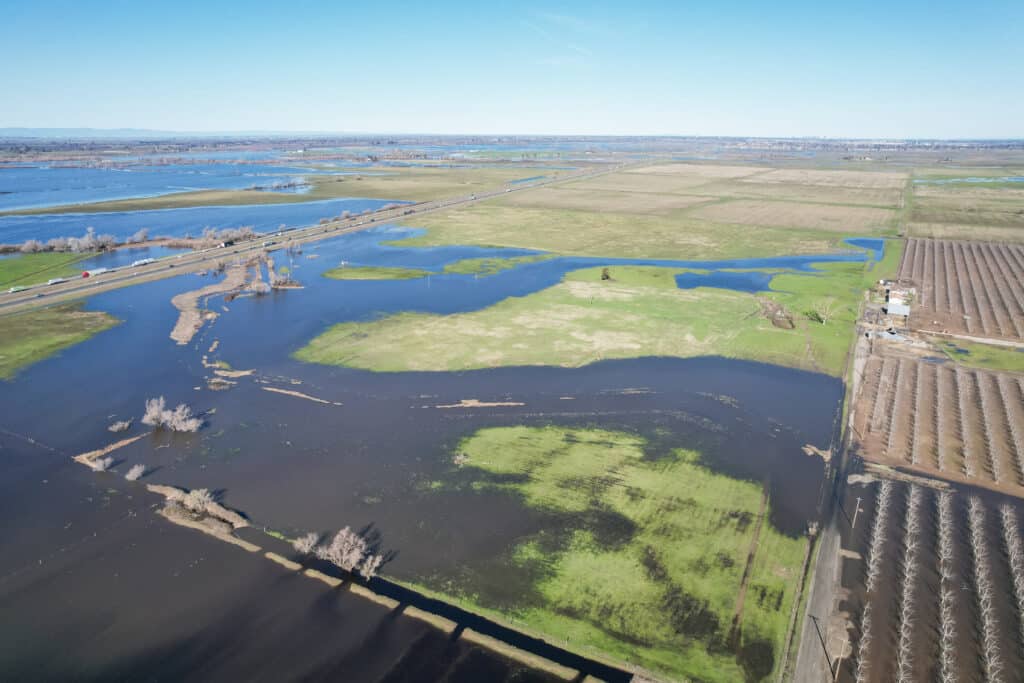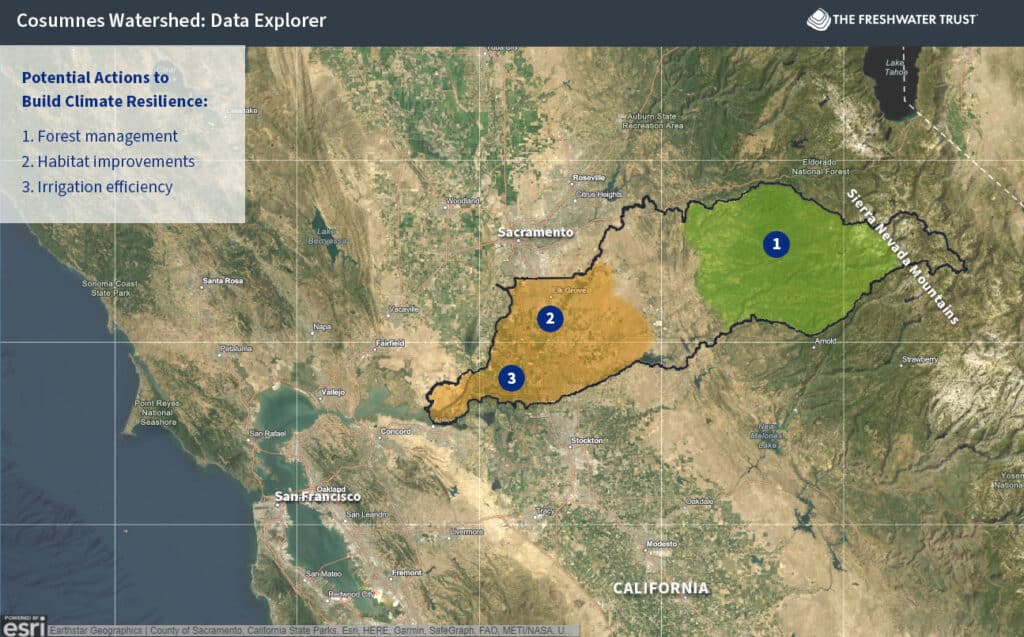Coordinated, Data-Driven Investment Approach to Build Resilience in California’s Cosumnes Watershed
July 12, 2023
The Cosumnes River flows freely out of California’s Sierra Nevada mountains, past Sacramento, through the agriculture-rich Sacramento–San Joaquin River Delta, where it meets the Mokelumne River and travels out to San Francisco Bay. Its upper watershed is densely forested due to decades of fire suppression alongside open expanses formed by massive wildfires. In the lower watershed, heavy groundwater withdrawals for agriculture and development deplete the river’s flow, while making it more expensive to get drinking water and grow crops. In just the last two years, the communities and ecosystems in this watershed have experienced catastrophic droughts, fires, and floods.

In the face of these urgent climate-driven pressures, we must rapidly deliver “natural infrastructure” project dollars to thin forests, implement better water use technology on farms, and improve habitat in the streams and wetlands of the Cosumnes. We still have time to give agencies and partners the tools, authority, and insight to speed up their response in a way that gives the Cosumnes a chance of withstanding cycles of drought, flood, and fire—but that window for action is closing.
The Freshwater Trust (TFT) is piloting a new, data-driven approach in the Cosumnes that will help secure more funding, coordinate that funding, deliver it to the best projects, and make it simpler for everyone to do the right thing.
While this approach may sound commonsense, there are several structural barriers standing in the way that TFT and partners are actively trying to overcome. To secure a resilient Cosumnes watershed will likely require several hundred million dollars. This challenge is big enough already, so we need to take some steps to streamline and simplify how government pays for these kinds of projects and put data in the hands of decision-makers so that they can make smart investments in projects that give us the best bang for the buck.
As currently structured, conservation funding agencies cannot make the big impact that is needed. While funding amounts start out big, they are subdivided among multiple programs that then disburse them project by project. While all these funders care about climate resilience, each is focused on a sliver of the problem, which makes it difficult for them to work together. And without uniform and consistent metrics for investment, it’s nearly impossible to know how much investment is needed, where it should go, and what progress is being made against needs.
In a state almost constantly suffering from drought, flood, or wildfire, we must rethink old approaches and maximize new tools.
In the Cosumnes, TFT is now working with partners to implement a Watershed Outcomes Bank. The Bank isn’t a whole new system but seeks to aggregate multiple funding pots and coordinate implementation efforts into an aligned, data-driven strategy that helps deliver a lot more good projects a lot faster.
To pilot the Watershed Outcomes Bank in the Cosumnes, TFT received a grant from the U.S. Endowment for Forestry and Communities’ Innovative Finance for National Forests Program and funds from Blue Forest Conservation. This funding allows TFT to work with the U.S. Forest Service, the Healthy Eldorado Landscape Partnership (HELP)—a group focused on implementing projects on national forest land—and downstream partners to bring together more dollars, more coordinated investment, and the power of technology to secure bigger, better outcomes.

To implement the Watershed Outcomes Bank, TFT intends to create a central hub for coordinating and concentrating funding to high-impact and cost-effective projects throughout the watershed. This model creates more options for meeting agencies’ “match” requirements, centralizes transactions to cut down on costs, applies environmental and economic data to target investments, and empowers local groups and stakeholders. More specifically, rolling out the Bank approach includes these steps, some of which are already under way:
- Set clear and quantifiable goals. TFT and partners are identifying a set of measurable watershed targets that help create conditions for a more resilient watershed. For example, how much more water is needed, how much cleaner must it be, how much carbon must be avoided or sequestered, and how much forest must be treated?
- Prioritize projects that will most quickly accomplish the goals. TFT and partners will identify key project types—such as forest thinning, more efficient irrigation upgrades, and groundwater replenishment projects—and use geospatial tools to assess available project supply within the watershed.
- Evaluate every potential investment by a common measuring stick. For each project type, TFT will calculate costs and standard environmental benefits linked to the watershed targets, such as increased water volume, reduced sediment loads, and greenhouse gas reductions. This cost-benefit evaluation will help identify the type and number of projects for most cost-effectively achieving targets.
- Use this information to secure a much bigger pot of funding. This work will complement conservation-focused work already underway in the basin, including the Sacramento Regional County Sanitation District’s $650-million recycled water and groundwater replenishment Harvest Water program in the lower watershed, which TFT helped design and permit and which just received $292 million in funding from California. Additionally, the pilot connects to water replenishment project investments made by Amazon Web Services and Microsoft in the watershed, and deepens partnerships with water user groups such as Omochumne-Hartnell Water District and Sloughhouse Resource Conservation District.
- Ensure that every dollar invested is part of a coordinated strategy. TFT will work with funders and partners to invest in a coordinated series of multi-benefit projects across the watershed and track the progress toward collectively achieving the watershed targets.
TFT considers this integrated, stepwise approach critical to success. This insight helps decision-makers see a pathway for achieving goals that have otherwise felt unattainable and undefinable, and it helps coordinate multiple participants around an articulated target. Without it, the risk of misfiring is too high, especially as the climate crisis grows more urgent. Importantly, this approach builds on California’s “regional integrated watershed management” (IRWM) program, and helps make real the “watershed climate risk assessment,” “investment and implementation plan,” and requirement to use “uniform analytic standards to facilitate project selection and performance evaluation” called for in Section 91031 of the recently introduced California Climate Bond (Senate Bill 867).
TFT is excited to kick off the Watershed Outcomes Bank pilot. Beginning to rethink and more strategically integrate our public investments is a big lift, but we will fail if we don’t try. We hope that the lessons learned from this pilot in the Cosumnes will illustrate an improved model for finally catching up to, and hopefully getting ahead of, the climate crisis.
—–
The United States Endowment for Forestry and Communities is a not-for-profit corporation that works collaboratively with partners in the public and private sectors to advance systemic, transformative and sustainable change for the health and vitality of the nation’s working forests and forest-reliant communities.
#California #conservation finance #Cosumnes #Delta #policy #Sacramento #U.S. Forest Service #watershed outcomes bank
